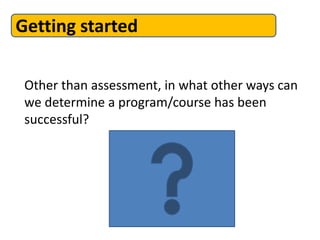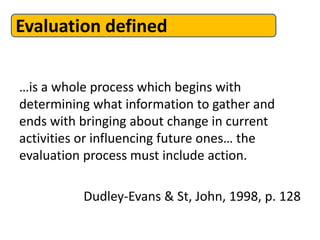Language course evaluation
- 1. Language Course Design: Program Evaluation
- 2. Getting started Other than assessment, in what other ways can we determine a program/course has been successful?
- 3. • Definition of evaluation. • Approaches and dimensions in program evaluation. • Evaluating a program. In this class
- 4. Evaluation
- 5. Evaluation defined …is a whole process which begins with determining what information to gather and ends with bringing about change in current activities or influencing future ones… the evaluation process must include action. Dudley-Evans & St, John, 1998, p. 128
- 6. Evaluation defined …is a process of collecting, analysing and interpreting information about teaching and learning in order to make informed decisions that enhance students’ achievement and the success of educational programs Genesee, 2001, p. 144
- 7. Evaluation defined …the systematic collection and analysis of all relevant information necessary to promote the improvement of a curriculum and assess its effectiveness within the context of the particular institutions involved… Brown, 1995, p. 218
- 8. Key factors in evaluation •Evaluation is not restricted to testing learners’ abilities. •More than just the product is important… •The success or failure of a program depend on a number of different conditions. •Other information…related to learning and teaching… should be included in a program evaluation. Rea-Dickins & Germaine, 2001, p. 255
- 10. Approaches Product-oriented Static-characteristic Process-oriented Decision-facilitation •Determine that the program’s goals has been achieved •Rely heavily on assessment. •Conducted by outside experts. •Based on the examination of accounting and academic records •Carried out both in descriptive and judgmental terms. •Include unexpected outcomes. •Emphasis on formative evaluation •Avoid judgments, inform decisions. •Evaluation is seen as cyclical and on- going.
- 11. Dimensions Formative Summative Process Product Quantitative Qualitative Purpose of the evaluation Types of information Types of data and analysis Based on Brown, 1995
- 13. The evaluation process Articulate the purposes of evaluation Identify and collect relevant information Analyse and interpret information Make decisions Genesee, 2001, p. 145
- 14. Before doing program evaluation Audience and purpose Criteria for evaluation Criteria for analysis of the results Sources of information Dudley-Evans & St. John, 1998, p. 130-131
- 15. Purposes
- 16. Purposes Purposes of Evaluation Accountability Students status in a program Instruction and learning Genesee, 2001, p. 146
- 17. Purposes Purposes of Evaluation Accountability Curriculum betterment/development Teacher development Specific topic related purposes Rea-Dickins & Germaine, 2001, p. 253
- 18. Purposes Specific topic- related evaluation Materials evaluation Teacher training Rea-Dickins & Germaine, 2001 Class observation Self- assessment Peer- assessment
- 20. Instruments and data- collection methods •Checklists and questionnaires •Quizzes and tests •Classroom observation •Classroom diaries •Record keeping
- 21. References • Brown, J.D. (1995). The elements of language curriculum: A systematic approach to program development. Heinle & Heinle Publishers. • Dudley-Evans, T. y St. John, M. J. (1998). Developments in English for Specific Purposes: A multidisciplinary approach. Cambridge: Cambridge University Press. • Genesee, F. (2001). Evaluation. En Carter, R. y D. Nunan (Eds.) The Cambridge guide to Teaching English to Speakers of Other Languages (pp. 144-150). Cambridge: Cambridge University Press. • Rae-Dickins, P. y Germaine, K. (2001) Purposes for evaluation. En Hall, D.R. y A. Hewings, (Eds.) Innovation in English language teaching. A reader (pp. 253-262). London: Routledge.





















